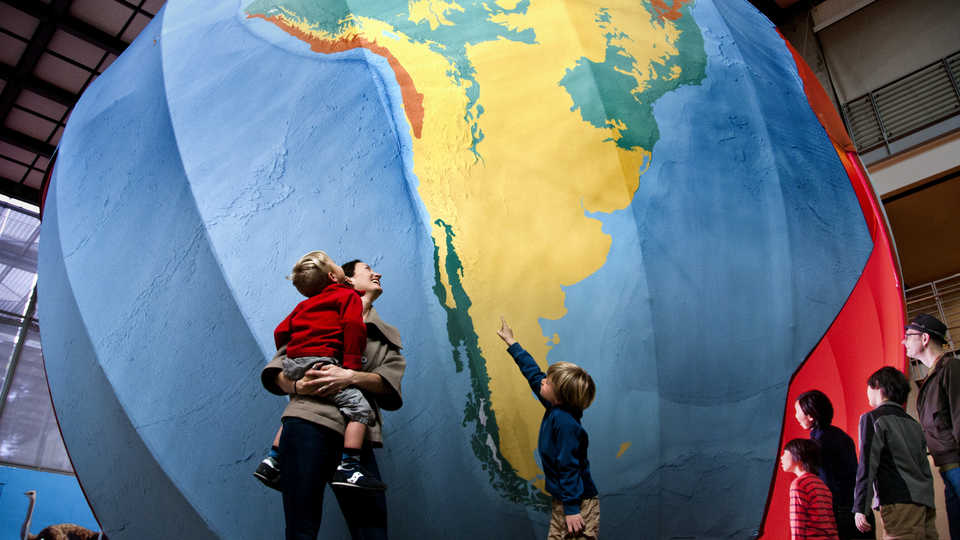Quake simulator, live ostriches, hands-on programs, and more will unearth the science behind our ever-changing planet

SAN FRANCISCO (May 23, 2012) — Prepare to be moved! Earthquake: Life on a Dynamic Planet, will open at the California Academy of Sciences on May 26, 2012, taking visitors on a kinetic journey toward understanding these super seismic phenomena and how they fit into the larger story of our ever-changing Earth. Occupying the entire west hall of the Academy, the exhibit will feature a number of large-scale installations, including a walk-through model of the Earth, an enclosure for live baby ostriches (yes, there are surprising connections between earthquakes and ostriches!), an earthquake simulator resembling an old Victorian home, and an interactive space designed to teach earthquake preparedness. Concurrently, a new planetarium show will launch audiences on a breathtaking tour through space and time—flying over the San Andreas fault before diving into the planet's interior, traveling back in time to witness both the 1906 San Francisco earthquake and the break-up of Pangaea 200 million years ago, and much more.
"San Francisco—and California too—are no strangers to the awesome power of earthquakes," said Dr. Greg Farrington, Executive Director of the Academy. "By showing visitors the science that underlies these natural events, we want to encourage preparedness and help visitors understand how the great movements of the continents have produced the landscape we call home today and the life around us.
Exhibit Overview
The 8,000-square-foot exhibit, titled Earthquake: Life on a Dynamic Planet, is located next to the Rainforest dome and continues the new Academy's tradition of light-filled, airy exhibit spaces integrated with live animals and public programs. The exhibit will run for several years.
- Walk-through Earth
Entry into the Earthquake exhibit is through a dramatic, 25-foot-diameter model of the Earth. Venturing through an oversized crack in the planet's crust, visitors will find touchable geology specimens and interactive stations explaining the basics of plate tectonics. Activity deep inside the planet drives the motion of tectonic plates on the Earth's surface, resulting in the earthquakes we feel and the continental movements that happen more slowly—over millions of years.
- How Land Shapes Life
The break-up of the supercontinent Pangaea roughly 200 million years ago resulted in two large landmasses: Laurasia (present-day northern continents) and Gondwana (present-day southern continents). The second section of the Earthquake exhibit will focus on the diverse life forms that evolved and spread out across Gondwana, showing visitors that the same earth processes that cause destructive earthquakes in the human timescale can also provide constructive conditions for life in the geological timescale.Live ostriches, ancient fossils, plants, and mounted marsupials (mammals with pouches) will illustrate the shared legacy of India, Antarctica, Australia, South America, and Africa, which were once joined together. For example, the iconic ostriches of Africa are large flightless birds whose closest relatives are scattered today in continents thousands of miles apart. Yet they all evolved from a common ancestor, one that lived during a time when all the southern continents were connected. Their distribution today is evidence that the Earth's landmasses have moved great distances in the past. To tell this story, the Academy is hatching out live ostrich chicks during Earthquake's opening months. The chicks will be on view in the exhibit until December 2, 2012.
- Earthquake Simulator
Following a brief pre-show, visitors will enter an earthquake simulator designed to look like an old Victorian home in San Francisco. Inside, simulated views of the downtown skyline and sounds of the World Series baseball game will transport guests back to 5:04 pm on October 17, 1989—the date and time of the infamous Loma Prieta earthquake. A sudden tremor, lasting 15 seconds, will give visitors a sense of what this ground-jolting event felt like.But the experience doesn't end there—the views of downtown will darken and change, and the sounds of the radio will give way to the clip-clop of a horse-drawn carriage. For a second simulation, guests will travel farther back in time, to 5:12 am on April 18, 1906, the date of the most devastating earthquake in San Francisco's history. About 32 times stronger than Loma Prieta, this event brought the "Paris of America" to its knees, and the ensuing fire destroyed thousands of buildings, including the original Academy home on Market Street.
- Earthquake Preparedness
What should you do before, during, and after an earthquake? The final section of the exhibit will address these questions through hands-on activities. Visitors can identify crucial items for home preparedness kits (such as food, water, and hand-crank radios) and learn what to do after an earthquake (for example, checking for hazards and turning off the gas meter). This section will also include a resource station offering additional preparedness advice from partner organizations.
Additional Information
During the summer of 2012, Academy educators will shake things up with daily programs and hands-on demonstrations on the topics of geology, preparedness, and much more. In addition, the Academy will hold an Earthquake Premiere Party on the evening of May 25, 2012, featuring a 1906 period theme with dancing, music, and cocktails. Visit www.calacademy.org/earthquake for details.
The Earthquake exhibit is generously supported by Ann L. and Charles B. Johnson, Lakeside Foundation, Pacific Gas & Electric Company, American Red Cross, Safeway, The Bernard Osher Foundation, and the California Earthquake Authority.
Press Contacts
If you are a journalist and would like to receive Academy press releases please contact press@calacademy.org.
Digital Assets
Hi-res and low-res image downloads are available for editorial use. Contact us at press@calacademy.org to request access.